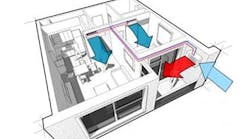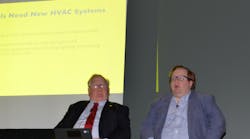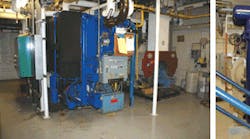Amid all the talk about rising energy costs, energy efficiency, carbon emissions, green buildings, and sustainability, it would seem that convincing building owners to replace aging, inefficient chillers with new, environmentally friendly units would be a relatively easy sell.
However, there’s often a disconnect between what should be and what is, and that’s the case in the chiller replacement market. Despite all the advantages the new units offer, many building owners still stubbornly cling to their old chillers.
According to the Air Conditioning, Heating and Refrigeration Institute (AHRI), since the ban on CFC refrigerants took effect in 1996, less than 60% of the estimated 85,485 large-tonnage CFC chillers in the U.S. and Canada have been replaced or converted to enable the use of non-CFC refrigerants. AHRI estimates that more than 35,000 CFC chillers still operate in North America. AHRI and Congress are trying to help boost chiller replacements. The Cool and Efficient Buildings Act (HR-1241) sponsored by Rep. Peter Hoekstra (R-MI) reportedly would have given building owners an incentive to switch to more efficient equipment by reducing the current, 39-year depreciation period of commercial rooftop air conditioners or chillers to more closely match the units’ life span. The bill was never passed.
While passage of the Act would very likely have boosted chiller replacement sales, commercial contractors and building owners can’t afford to sit and wait for a legislative solution.
So how can quality contractors get their customers to think “replace” instead of “repair?”
Many Factors Influence the Decision
“Large tonnage chiller replacements are an important part of our business, and there are many factors in the decision to replace a chiller,” says Dave Holmquist, manager, central chillers, Owens Companies, Inc., Minneapolis, MN. “Unfortunately, energy savings has not been the primary reason for replacement. It is a rare event when a perfectly operational chiller has been replaced. Usually there are other issues that ignites the decision to change out a chiller, such as compressor failures, failed heat exchangers or leaking chiller bundles.”
However, Holmquist says he believes energy savings will factor in more and more as the cost of energy increases.
“When you consider chillers over 20 years old, the kW/Ton is about 0.8 to 1.3. Today, kW/ton is easily attained in the 0.3 to 0.5 range depending on heat exchanger style, compressor and variable speed drive application.”
Consider a 400-ton chiller operating at 0.84 kW/ton under design conditions. With the cost of electricity estimated at 10 cents/kWh, the cost to operate the chiller would be $46 per hour. Now consider operating an energy efficient chiller operating at 0.4 kW/ton. The cost to operate this chiller would be approximately $22 per hour. For 3,000 hours of operation, the savings would be $72,000 per year. That kind of number will get building owners’ attention.
Holmquist is in his 32nd year at Owens Companies. He points out that if energy savings is truly the objective in a chiller changeout, attention should be given to the entire chilled water plant.
“Most chilled water systems operate as either primary flow or primary/secondary flow,” he says. “During part load, some of the chilled water flowing through the loop never picks up a load. This is a waste of energy. If we can send every drop of water through a load before it returns to the chiller, the system is fine-tuned, using only the energy needed to achieve its goal. That goal is to maintain a chilled water temperature required for the application.”
Holmquist says this can be accomplished by applying variable speed drives to all portions of the chilled water plant. This includes all chillers, pumps, and cooling tower fans, and the conversion of chilled water control valves to two-way valves. The energy savings are greatly increased and the ROI is attractive for many applications.
The growth of the LEED® (Leadership in Energy and Environmental Design) program has become an important issue within the HVAC industry that may lead to more chiller changeouts. “As more owners of buildings become aware of LEED for existing buildings, contractors should re-enforce the idea of replacing their chiller for energy savings first,” Holmquist says. “Don’t wait for chiller failures or problems to be the leading factor in chiller replacements.
Gerry Wiegmann, president of Wiegmann Associates, St. Charles, MO, says talk of a chiller replacement presents the perfect opportunity for contractors to look at the whole building with a customer. “When we look at the big picture, and think about how much has changed in buildings in general and this customer’s building in particular since the last generation of chillers was installed, there’s always opportunities to go in and do more than just swap chiller for chiller,” Wiegmann told CB.
To Wiegmann’s way of thinking, retrofitting a chiller doesn’t make much sense. “We have never retrofitted a chiller,” he says. “It seems to me that the manufacturers have an unfair advantage on that playing field. They get to buy the parts cheaper, and they have standard retrofit packages they can implement. What the manufacturers can’t do are the things we can, such as reanalyzing the whole building and performing an energy analysis to save the customer the most money by considering not only first cost but also energy and maintenance costs.
“Usually we can show customers that a new chiller, along with our other energy saving measures, makes good sense financially, and they can finance the replacement just based on their energy savings,” he adds. “In many cases we’ll even offer to do the financing for them. When they see that kind of confidence and wherewithal from our company, and look at our track record of energy savings, they’ll usually decide to go with a new chiller.” Controls work is another key. The capabilities of modern controls systems far exceed those of older generation building controls, and offer another selling point for the savvy contractor.
“When we install new controls, it gives us an in-depth knowledge of the building, and how our new chiller system will work in that building,” Wiegmann says. “It gives us the ability to share data with a customer and gives us a huge advantage over someone who’s just offering to retrofit or swapping out a chiller.”
According to AHRI, when properly sized for the space and properly maintained, a new, efficient and reliable chiller is one of the most significant yet easiest energy efficiency measures a building owner can undertake. All that remains is for you to help your building owner customers to see their investment in that light.
A CHILLER CHECKLIST
- What’s the age of the existing chiller? The typical life span of an air-cooled chiller is about 12 years, for water-cooled chillers it can be 20+ years. If a chiller is at or approaching the end of its life span, that should be a point in favor of replacement rather than repair.
- Are major repairs (such as a compressor changeout or condenser coil or tube replacement) needed? If so, that money may be better invested in a new chiller.
- What’s the old chiller’s efficiency rating? The kW/ton ratings of new chillers are improving every year.
- Is “green” important to the building owner? Is he or she aware of the refrigerant phase-out dates, and the fact that HCFCs are being replaced by HFCs?
- Are there noise considerations? New chillers can have lower decibel ratings than older models.
- What’s the old chiller’s footprint? This can be an important factor with large centrifugal chiller replacements in a limited space. A new, smaller chiller may open up square footage for additional equipment in the same space.
- What other energy considerations, such as converting to ice plants or thermal storage for off peak demand savings, can be looked at along with a chiller replacement?
- Are LEED® (Leadership in Energy and Environmental Design) existing building points important to your customer?
- Can your customer benefit from rebates from the electric company if he or she chooses to install a new chiller?
- Are performance contracting or equipment financing incentives available on replacement equipment?
— List provided by Chip Lafferty, CEO of Hill York, with locations in five Florida cities.










